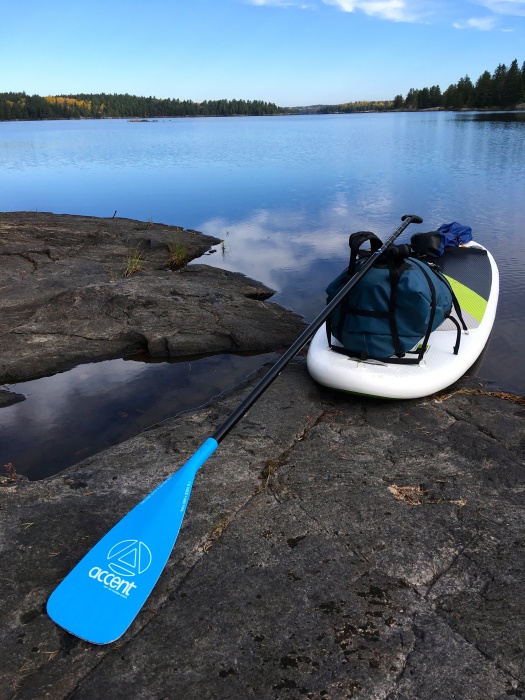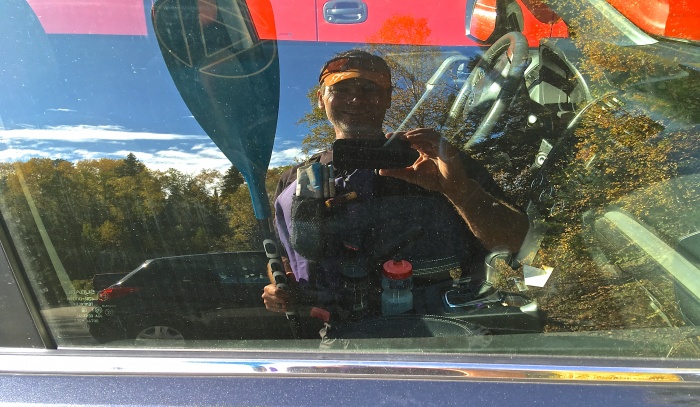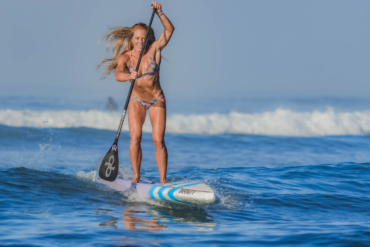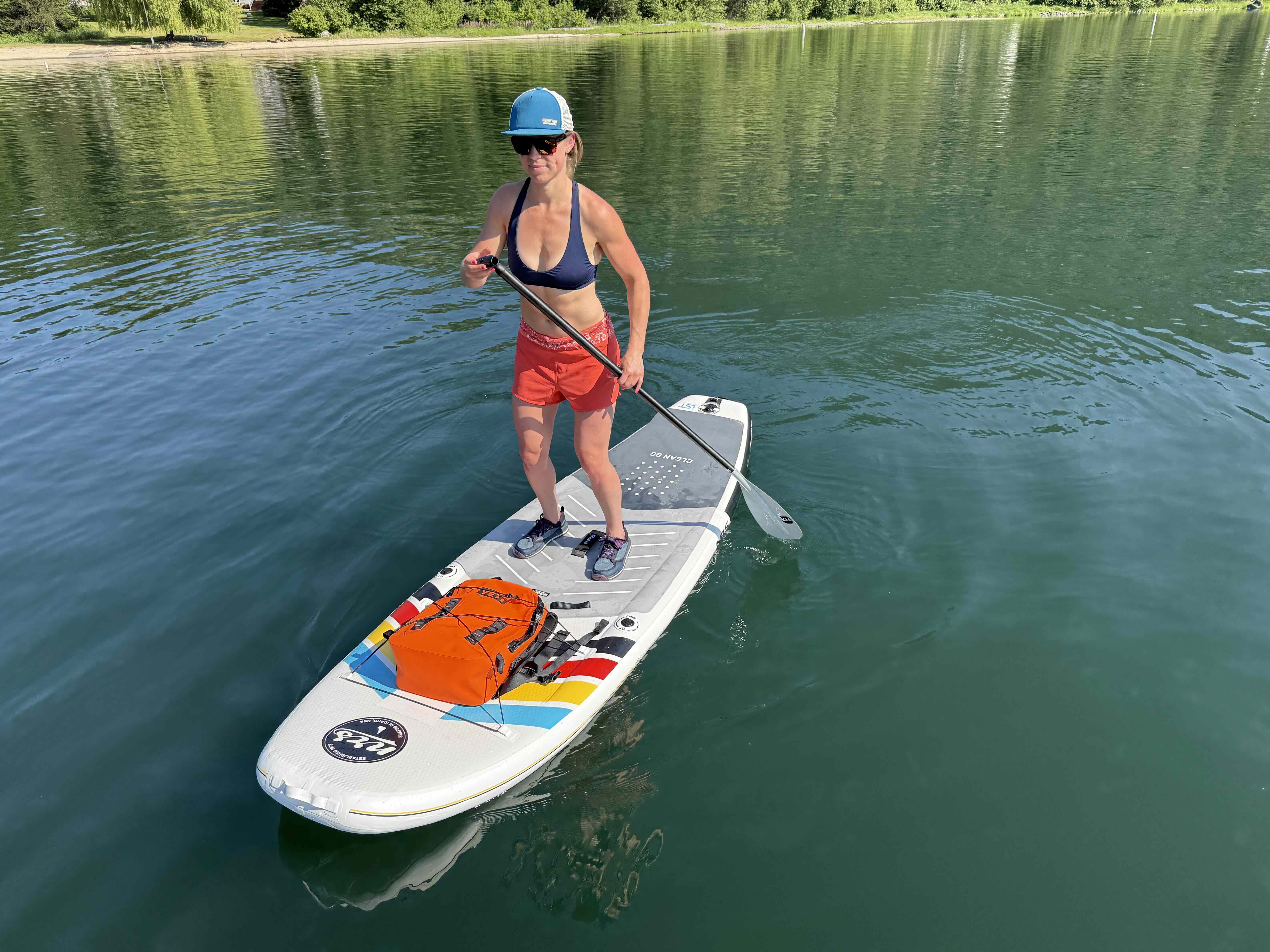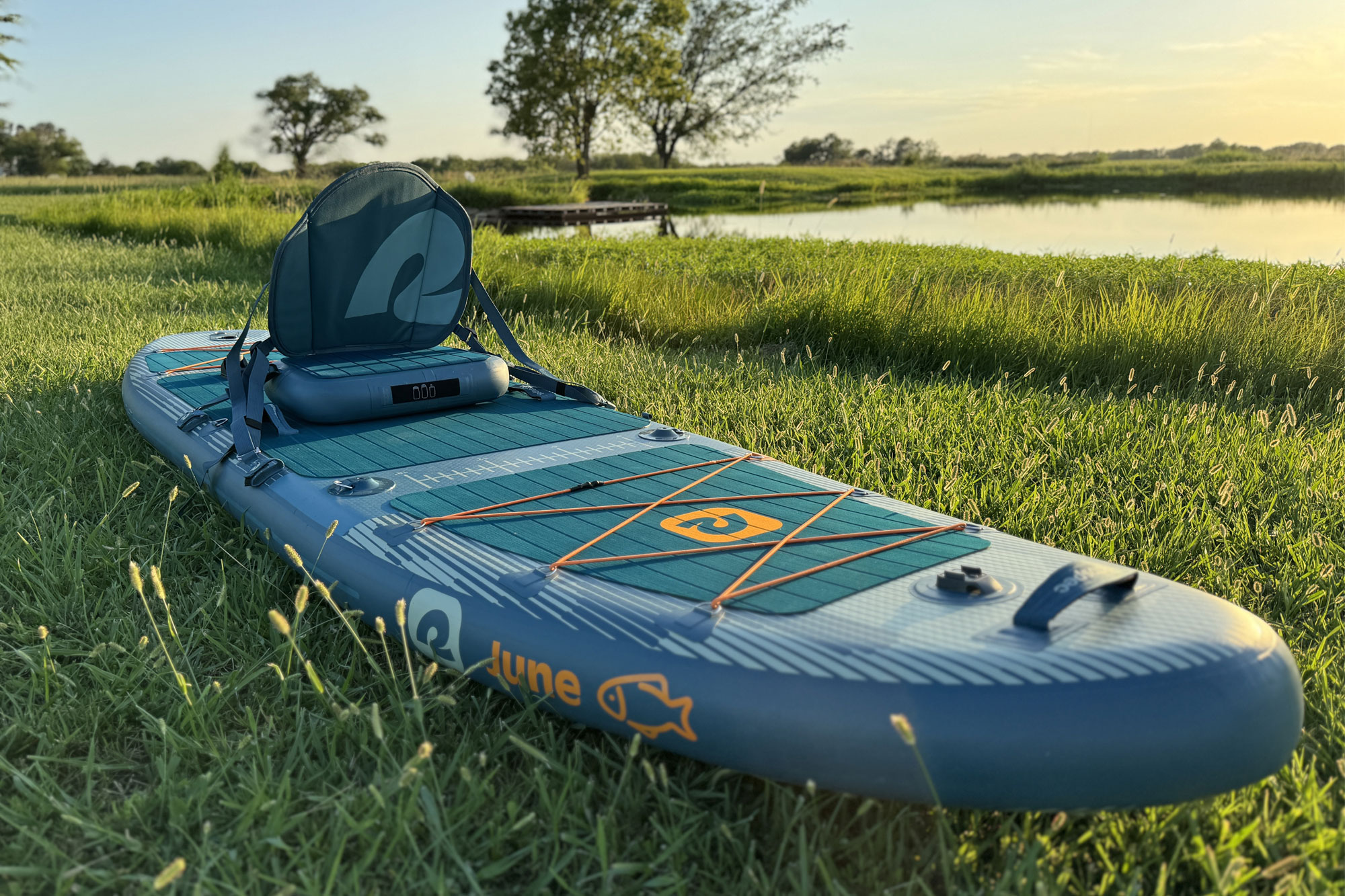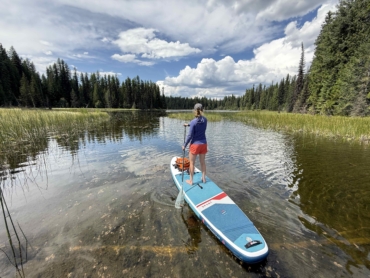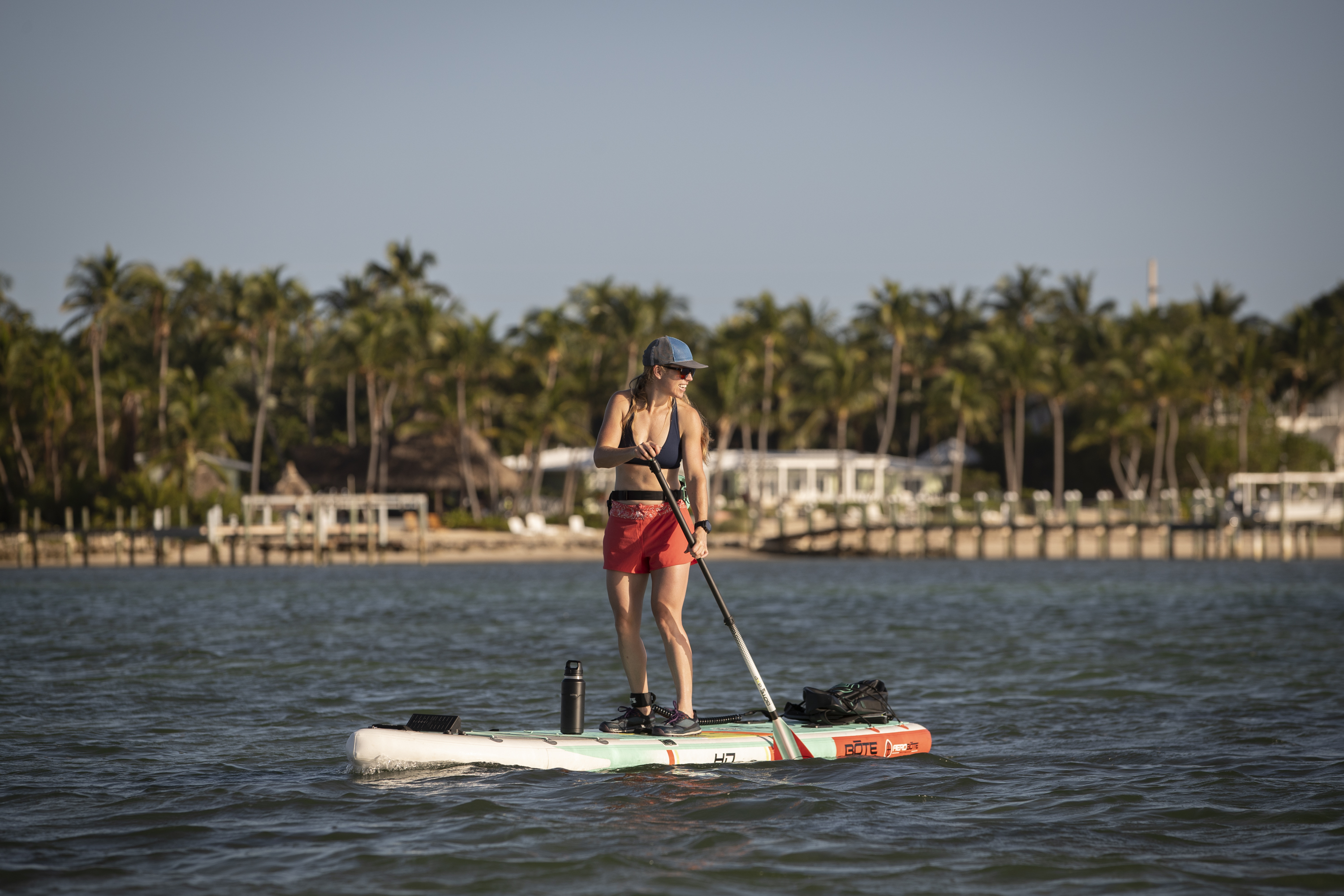On October 4, 2017, I set out on a trip unlike any I had ever taken before: stand-up paddleboarding the Boundary Waters Canoe Area Wilderness.
Inspiration struck two months earlier. For years I had dreamed of making a solo trip into the Boundary Waters Canoe Area, and to make it work I assumed I would need a solo canoe.
I never imagined that I would make the trip standing up.
But last summer my wife, Liana, and I bought an inflatable stand-up paddleboard. It was an innocuous purchase meant to add a little summer fun for us and our kids. But it set in motion a journey that would take me through miles of America’s most expansive wilderness and deep into my own being.

For a couple 40-somethings accustomed to climbing into kayak cockpits and paddling from our seats, the stand-up paddleboard was an instant hit. Liana loved the balance challenge and core muscle workout. Secretly, I think she enjoyed being much better at it than me.
My daughters and their friends used the paddleboard as a mobile floating dock, perfect for jumping off, swimming under, and crawling back onto for entire summer afternoons. Compared to our plastic whitewater kayaks, carrying this new paddleboard was a breeze.
And once I got a feel for the technique (and stopped falling off), paddling from my feet was a blast. (Think golf or baseball swing – it’s all in the hips.)
Gearing Up to Paddle the BWCA
I went into the garage and dug out my dry pack, stuffed it with blankets and coats, and strapped it to the paddleboard deck. A perfect fit. On the bathroom scale, minus my own weight, the pack weighed 25 pounds.
Time for a test.
After strapping the pack onto the deck and pulling the NRS Imperial 4 paddleboard into the water, I stepped on and pushed off. Happily, the board never sunk, even as I experimented with heavier and heavier loads. I jammed a bike lock, a tackle box, and jug of water into the pack – about 35 pounds total. Still buoyant.
Standing barefoot, I paddled flat water for 2 hours straight. Into headwinds and crosswinds, I paddled on my knees. Sandals, neoprene booties, Gore-Tex dry pants, and rubber-soled muck boots took me the rest of the way. I studied maps of the Boundary Waters, practiced compass skills, and chose a route that followed creeks and rivers. But I still avoided the big lakes like Basswood and Lac La Croix, where whitecaps and strong headwinds might stop me altogether.
Nearly every day for six weeks, I walked three blocks from my house to Brownie Lake in Minneapolis, hauling the pack and paddle, and carrying the board under my arm like a surfboard.
On a test run, I paddled from Brownie Lake, then to Cedar Lake, and finally to Lake of the Isles while my third-grade daughter, Maia, rode shotgun. She loved it. Not everyone in my family was as enthusiastic as Maia, though.
“Tell me why this is a bad idea?” I asked my wife. “It’s lighter than a canoe, and we’ll save money on a rental. What am I missing?”
“Has anyone else done it?” Liana replied.
“I have no idea.”
“Did you Google it?”
“No,” I said. And then of course, I did. I didn’t find much.
“Take a staycation, Dad,” my sixth-grade daughter, Siena, said.
Nice thought, but no.
Boundary Waters By SUP
On the morning of October 4, I pulled into an empty slot near the trailhead at entry point number 23 to Mudro Lake, opened the car door, and stepped out. The scent of pine and the rich, damp smell of mud filled the air.
Northern Minnesota in early October is the best place on Earth when the conditions are good. And the conditions could not have been better that morning. The temperature was up 15 degrees from an hour ago – 58 according to my dash thermometer. Overhead, yellow birch leaves rattled softly in a light breeze from the south. After recent days of heavy rain, I couldn’t find a cloud in the sky. Yet I was still nervous.
I wondered why. In 20 years, I’d kayaked more than 50 different whitewater rivers, paddling up to 12 hours per day. I once canoed across 30 lakes in the Boundary Waters in a single day. But stand-up paddleboarding, I’d learned, was different. It was more like trail running or cross-country skiing than canoeing or kayaking. Paddling for an hour is a solid workout, 2 hours a slog, 3 hours a marathon.
Fifty feet from the trailhead, four men in camouflage coats and rubber boots unloaded life vests and fishing poles, four bulging green-canvas Duluth packs, and two 16-foot camouflage Kevlar canoes from the beds of their pickups. I climbed onto my rear tire and undid a pair of red straps. Slowly, I lifted my inflatable SUP off the roof and set it gently down on the pavement.
“Be careful with the fins,” I told myself. “Don’t break something before the trip even starts.”

From the back seat, I grabbed the pump and inflated the board to 15 psi. I then packed the pump and a small repair kit – including a valve wrench, spare patches, a tube of adhesive, and a bottle of acetone – into a dry bag. I then fastened it with bungee cords to a pair of D rings on the stern of the deck.
With luck, I wouldn’t need any of this, and the conditions would hold. I’d stay on the board and out of the water, find every portage trail, avoid turning an ankle, manage the mud, and stay hydrated and warm. With any luck, I’d be back at my car in four days, healthy, recharged, and somehow (I hoped) different.
Perhaps I’d be wiser, immune to all the noise and endless political chatter, oblivious to news of Russia and hurricanes and Twitter – grounded to what truly matters. Maybe this silly SUP would reaffirm that when we strip away our gadgets – all these tools with faces that flash and beep and glow – our world slows down, grows quiet. And then, finally, we can listen.
I took a deep breath and slung on my pack. I grabbed my board and paddle, and hiked to the edge of the lot, past the bridge, past the trail sign, into the wilderness.
Setting Out: BWCA on a SUP
Two hours later, I arrived at the south end of Horse Lake. A steady tailwind made the paddling easier than I dared hope, so I’d kept pace with the camouflaged canoes.
But it was on the portages where I truly shined.
A few years earlier on a trip to the Boundary Waters with friends, I injured my neck portaging an 18-foot Old Town canoe. The next morning, I couldn’t turn my head or feel the tips of the first three fingers on my right hand. The pain between my shoulder blades was ridiculous. We were two days in with three to go – three days of hell. Afterward, I made myself a promise: I would never embark on a wilderness trip again before training on the equipment I would actually use.
Genius, right?
But now, as I paddled north out of the bay and into open water, the wind shifted. Waves began racing in. Lake water sloshed under the soles of my muck boots. The paddleboard teetered, skipped, slapped at the surface. I bent my knees and curled my toes.
Blue blotches and wavy streaks on the lake darkened as the sun slid beneath a pool of clouds. Horse Lake suddenly looked huge. The shoreline bent away, then reappeared, and seemed to stretch ahead for miles. It dawned on me that, for the first time that day, I was completely alone.
I dropped to my knees, pried open the lever on my paddle grip, twisted, and shoved the paddle shaft down to its shortest position. My palms were slick with sweat, but my fingers were numb and stiff, brittle as talons. Leaning into the wind, I took 10 strokes on the right, 15 on the left.
Already I was exhausted.
After maybe an hour of hard paddling that felt like an entire afternoon, I made camp on a tiny island at the very north end of Horse Lake. Sheltered from the wind, I pitched my tent on a carpet of tawny pine needles, changed into dry clothes, and collapsed into my camp chair. Behind me, a squirrel dove into a den of deadfall, followed by the sound of chittering, tiny toenails clicking up and down pine bark, and acorn crumbs landing like soft rain on my tent fly.
Then nothing. Silence. I was alone on my own private island. It was 3:00 p.m. and I had forever.
Overnight the wind died. The water was a mirror. And for the next two mornings, as the autumn sun illuminated red pines and white birch trees were peaked in golden leaves, my paddleboard glided on the water so softly it seemed almost to hover. On day three, the wind finally picked up.
And that’s when I made my biggest mistake.
While dragging my gear-heavy paddleboard upstream along a river– stepping from rock to rock in what I thought was a series of shallow rapids – I slipped. Water rushed up and under the bottom of my dry-pants and into my boot. Now my wool sock was a sponge.
I learned to first unstrap the pack and set it on dry land, then carry the much lighter SUP up the rapids, returning for the pack.
But the lesson was far more obvious: Don’t be in a hurry.
Reflecting on a Solo BWCA Adventure
Later that evening, as my sock hung off the end of a stick to dry in the woodsmoke over my campfire, I watched moonlight on blue water rippling at the edge of stone. Pine shadows in the distance shimmered on a silver lake. Somewhere in the dark, I heard a single splash that sounded like a stone but I knew instead must be a fish. A creek whispered from the south as steam rose from the bay.
“I am so thankful for this place,” I thought.
The next morning – my last of the trip – I paddled flat water, shoveling my way along as water droplets dribbled from my blade. My gratitude resurfaced. I’m thankful for generations of Ojibway people who did not clear-cut the pines or dam the rivers or mine the ridges, as later generations of white industrialists did in places like Silver Bay and Virginia and International Falls. I’m thankful for those who worked to protect this place from an army of saws and shovels and boatloads of dynamite. And I’m thankful for the gurgling creeks and granite shelves that slide and vanish into lake after lake after lake.
And I thought of my mom on that last morning – of her passion, how she believed that our last, best places deserved respect and protection. I thought of my dad, who, before I left, gave me his adjustable saw and a weather radio still new in the box, sealed in bubble wrap.
“Better to take your time out there than to hurry back to the car and take chances,” he said. “You be safe. Let me worry.”

As I paddled south on Mudro Lake back to the car, I thought of my daughters and my wife, how they have not yet seen twin bald eagles soar above the Basswood River, or red maple leaves spinning from eddy pools that tumble into Wheelbarrow Falls, or pictographs of moose and swans (I think) painted on a granite cliff face rising from Crooked Lake.
I realized they have not yet seen the sun set over Fourtown Lake and the sky go from orange to pink to purple to blue, or a harvest moon reflecting on the still surface of the Horse River in the morning amidst a thousand autumn leaves the color of citrus. With luck, one day I’ll be back, they’ll be with me, and all of us will see this place together.
On my final portage, I met a group of three young men who’d been out 10 days. “The wind was rough at the start,” one of them told me. “Especially on Friday Bay.” He glanced at my paddleboard and nodded. “We’ve been asking ourselves if someone could SUP it out here. How’d it go?”
I paused. “If you plan on short paddling days, stay away from big water, and then get a little lucky with the wind, it’s definitely doable,” I said. “And fun. A lot of fun.”


